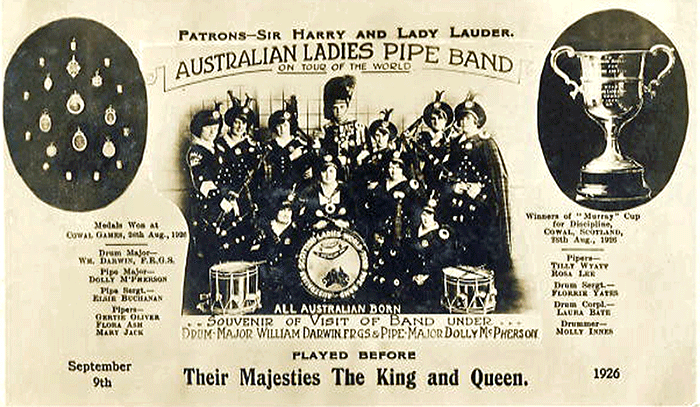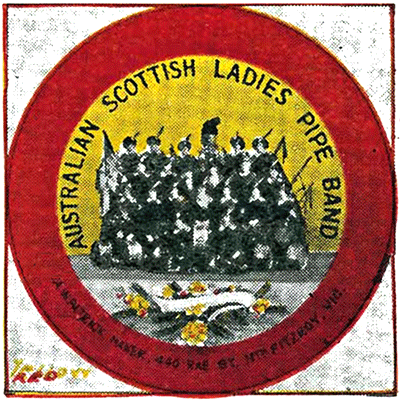
I have read the various stories on Piping Press concerning the Australian Ladies. According to newspaper reports, on their arrival in Glasgow on Thursday, August 26th, en route to Cowal, the band was welcomed at the station by 42,000 enthusiastic citizens and the Clan MacRae Society Pipe Band, the champion band of Scotland, under their P/M William Fergusson, which played them to their hotel.
Membership of the band was restricted to girls born in Australia who had Scottish-born grandparents, hence the tune the Exiles’ Return. Each of the girls had lost either her father or a brother in the war.
By Jeannie Campbell
At Cowal they were the guests of Sir Harry and Lady Lauder. On 9th September the band played before the King and Queen at Braemar. They returned to Glasgow to play a concert on Saturday, 11th September at Kelvingrove, where 15,000 paid for admission, the police having stopped the sale of tickets when it was estimated there were still 7,000 to gain admission.
The band was involved in a fatal road accident on Sunday, 12th September, 1926. This happened on the boulevard near Bowling in Dunbartonshire and left three dead and two of the girls in hospital. The dead included Robert D Lawrie, joint managing director with his brother James of the firm R G Lawrie, founded by their father.
The full story of the band and their tour is in my book ‘Pipe Bands’ which at present in sold out. Here is an extract:
The first ladies band in Australia was the South and Port Ladies Band which claimed to be two years older than the better known Australian Ladies. These bands were two of several founded at the end of World War I to raise money for returned soldiers and charities.
The South and Port Ladies was founded as a memorial band at a meeting on 31st January 1918. By March that year two of the pipers were able to play at an event and by April the band was playing in parades.
The Pipe Major was J W S Senter and his cousin James Center, the bagpipe maker, was the Pipe Sergeant. In December 1918 the band was described as having 14 lady pipers, six lady side drummers and a lady bass drummer. They were assisted by three gentlemen pipers and drummers and a drum major.

The idea of the Australian Ladies band had also come about during the war. While the servicemen were abroad on active service the girls thought of welcoming them home with the sound of the pipes. The idea proved so popular that membership had to be restricted to girls born in Australia who had Scottish born grandparents and each of the girls had lost either her father or a brother in the war.
Prior to their tour they had already raised thousands of pounds for soldiers’ charities by playing at concerts and events. On 3rd June 1924 Drum Major William Darwin, a songwriter and Gallipoli veteran, wrote in a letter to Prime Minister Stanley Bruce, ‘This band will be without any doubt one of the greatest advertisements that Australia has ever had, as it is a fully equipped Ladies’ Band, and there is no other of its kind in the World.’
Darwin was seeking government funding for the first world tour of a women’s bagpipe band, an idea first mooted in 1923. The Australian Scottish Ladies Pipe Band proposed to play venues on Australia’s eastern seaboard before sailing to New Zealand, South Africa, Honolulu, the United States, Canada and Britain.

The women also planned to visit the Empire Exhibition at Wembley in London and the former battlefields of France, where they would pay their respects to fallen friends and relatives. On 11th June, 1924, the Government announced that it had received an ‘astonishing number of requests … from instrumentalists who want to go to London during the Exhibition’.
All were rejected in favour of the Australian Imperial Band, an all-male outfit deemed more representative of the nation. In a further setback, the Caledonian Society, citing lack of financial viability, refused patronage of the ladies’ tour. Undaunted, band members spent the next six months lobbying potential sponsors, performing in the southern states and selling promotional photographs, mirrors and badges.
The band’s promotional activities fuelled rivalries such as this excerpt from the anonymously-penned ‘Wully’s Band’, which appeared in the Victorian Scottish Union journal, The Scot at Hame an’ Abroad, on July 15, 1924:
Sae roond th’ country side he gaes, collection boxes rattlin’,
For stil’ he’s short o’ many poonds; an’ still he’s brawly battlin’.
Sometimes th’ lassies, short o’ wind can’t keep th’ music goin’,
That’s just th’ time that Wully shines, he’s awfu’ guid at “blowin”!
Some parents were also becoming alarmed. In August 1924 the band came to the notice of the Prime Minister’s Department, when Mr PJC Wallace, the father of two band members, warned the Officer-in-Charge of Passports the trip was ‘a risky undertaking, both financially and morally’. Another setback occurred the week before their planned departure, when popular 19-year-old piper Marjory Cook died in a fall.
In 1923 the band had 22 members and it was led by Drum Major William Darwin and Pipe Major Mrs Jessie Young. Starting in May 1924 it embarked on its world tour, travelling firstly to the Northern States of Australia, then to New Zealand. The party included two chaperones.
In June 1925, the ladies were welcomed to New Zealand at a haka in Whakarewarawa on the North Island, where they in turn treated the locals to a programme of song, dance, recitations and pipe music.
For the next six months, billed as the ‘world’s greatest novelty’, they played radio stations, town halls and theatres from ‘Auckland to Bluff’, often returning for repeat performances that included a novel kangaroo dance and a recitation of Australia’s ‘Kilted Men’.
- To be continued.
The Bagpiper’s Handbook…a must have for all pipers






















Jeannie Campbell, you are a national treasure – thank you for all you do and have done !